Orevaoghene Ahia
MAGNET: Improving the Multilingual Fairness of Language Models with Adaptive Gradient-Based Tokenization
Jul 11, 2024



Abstract:In multilingual settings, non-Latin scripts and low-resource languages are usually disadvantaged in terms of language models' utility, efficiency, and cost. Specifically, previous studies have reported multiple modeling biases that the current tokenization algorithms introduce to non-Latin script languages, the main one being over-segmentation. In this work, we propose MAGNET; multilingual adaptive gradient-based tokenization to reduce over-segmentation via adaptive gradient-based subword tokenization. MAGNET learns to predict segment boundaries between byte tokens in a sequence via sub-modules within the model, which act as internal boundary predictors (tokenizers). Previous gradient-based tokenization methods aimed for uniform compression across sequences by integrating a single boundary predictor during training and optimizing it end-to-end through stochastic reparameterization alongside the next token prediction objective. However, this approach still results in over-segmentation for non-Latin script languages in multilingual settings. In contrast, MAGNET offers a customizable architecture where byte-level sequences are routed through language-script-specific predictors, each optimized for its respective language script. This modularity enforces equitable segmentation granularity across different language scripts compared to previous methods. Through extensive experiments, we demonstrate that in addition to reducing segmentation disparities, MAGNET also enables faster language modelling and improves downstream utility.
Voices Unheard: NLP Resources and Models for Yorùbá Regional Dialects
Jun 27, 2024Abstract:Yor\`ub\'a an African language with roughly 47 million speakers encompasses a continuum with several dialects. Recent efforts to develop NLP technologies for African languages have focused on their standard dialects, resulting in disparities for dialects and varieties for which there are little to no resources or tools. We take steps towards bridging this gap by introducing a new high-quality parallel text and speech corpus YOR\`ULECT across three domains and four regional Yor\`ub\'a dialects. To develop this corpus, we engaged native speakers, travelling to communities where these dialects are spoken, to collect text and speech data. Using our newly created corpus, we conducted extensive experiments on (text) machine translation, automatic speech recognition, and speech-to-text translation. Our results reveal substantial performance disparities between standard Yor\`ub\'a and the other dialects across all tasks. However, we also show that with dialect-adaptive finetuning, we are able to narrow this gap. We believe our dataset and experimental analysis will contribute greatly to developing NLP tools for Yor\`ub\'a and its dialects, and potentially for other African languages, by improving our understanding of existing challenges and offering a high-quality dataset for further development. We release YOR\`ULECT dataset and models publicly under an open license.
Teaching LLMs to Abstain across Languages via Multilingual Feedback
Jun 22, 2024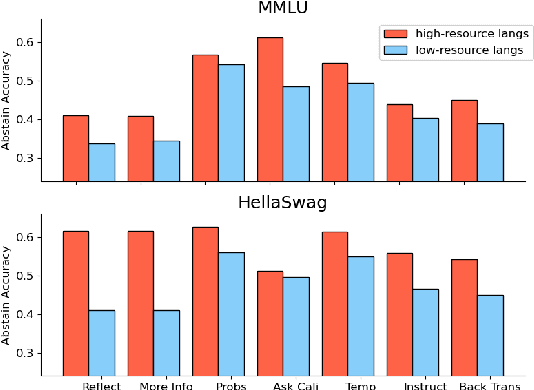
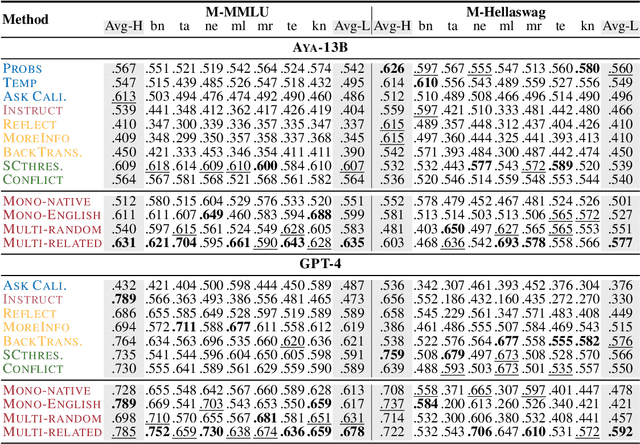
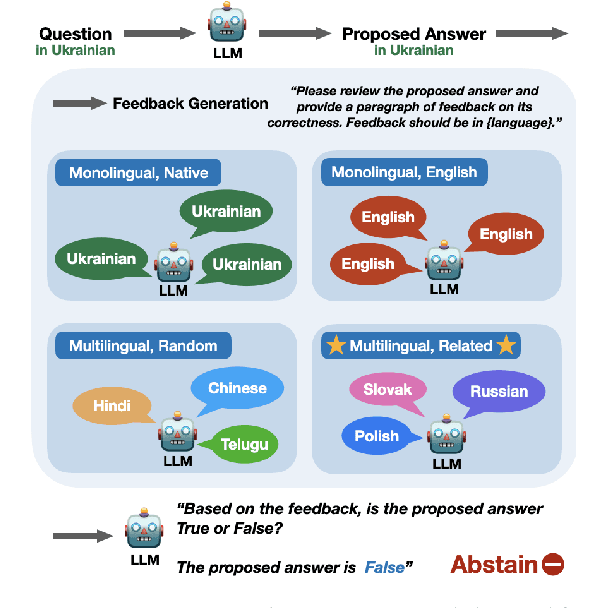
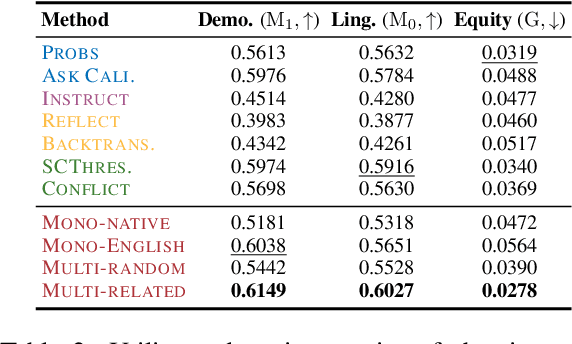
Abstract:Multilingual LLMs often have knowledge disparities across languages, with larger gaps in under-resourced languages. Teaching LLMs to abstain in the face of knowledge gaps is thus a promising strategy to mitigate hallucinations in multilingual settings. However, previous studies on LLM abstention primarily focus on English; we find that directly applying existing solutions beyond English results in up to 20.5% performance gaps between high and low-resource languages, potentially due to LLMs' drop in calibration and reasoning beyond a few resource-rich languages. To this end, we propose strategies to enhance LLM abstention by learning from multilingual feedback, where LLMs self-reflect on proposed answers in one language by generating multiple feedback items in related languages: we show that this helps identifying the knowledge gaps across diverse languages, cultures, and communities. Extensive experiments demonstrate that our multilingual feedback approach outperforms various strong baselines, achieving up to 9.2% improvement for low-resource languages across three black-box and open models on three datasets, featuring open-book, closed-book, and commonsense QA. Further analysis reveals that multilingual feedback is both an effective and a more equitable abstain strategy to serve diverse language speakers, and cultural factors have great impact on language selection and LLM abstention behavior, highlighting future directions for multilingual and multi-cultural reliable language modeling.
Critical Learning Periods: Leveraging Early Training Dynamics for Efficient Data Pruning
May 29, 2024Abstract:Neural Machine Translation models are extremely data and compute-hungry. However, not all data points contribute equally to model training and generalization. Data pruning to remove the low-value data points has the benefit of drastically reducing the compute budget without significant drop in model performance. In this paper, we propose a new data pruning technique: Checkpoints Across Time (CAT), that leverages early model training dynamics to identify the most relevant data points for model performance. We benchmark CAT against several data pruning techniques including COMET-QE, LASER and LaBSE. We find that CAT outperforms the benchmarks on Indo-European languages on multiple test sets. When applied to English-German, English-French and English-Swahili translation tasks, CAT achieves comparable performance to using the full dataset, while pruning up to 50% of training data. We inspect the data points that CAT selects and find that it tends to favour longer sentences and sentences with unique or rare words.
DIALECTBENCH: A NLP Benchmark for Dialects, Varieties, and Closely-Related Languages
Mar 16, 2024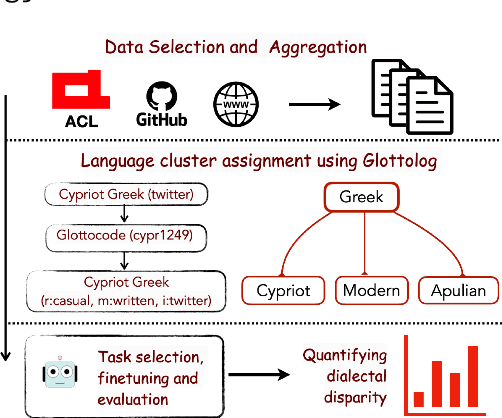

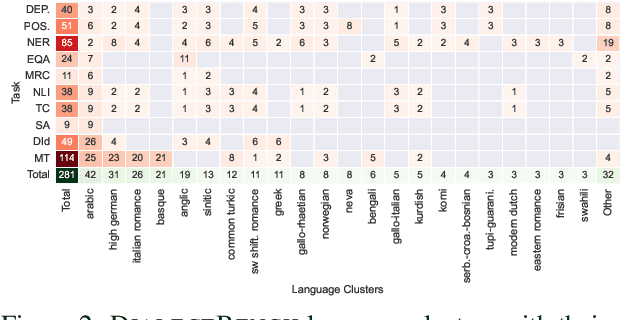
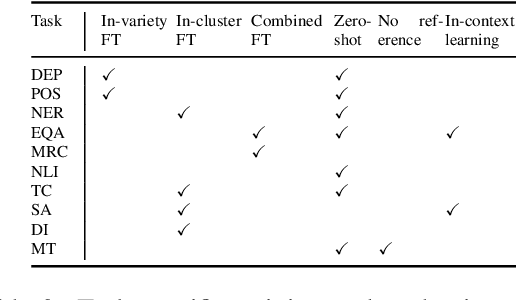
Abstract:Language technologies should be judged on their usefulness in real-world use cases. An often overlooked aspect in natural language processing (NLP) research and evaluation is language variation in the form of non-standard dialects or language varieties (hereafter, varieties). Most NLP benchmarks are limited to standard language varieties. To fill this gap, we propose DIALECTBENCH, the first-ever large-scale benchmark for NLP on varieties, which aggregates an extensive set of task-varied variety datasets (10 text-level tasks covering 281 varieties). This allows for a comprehensive evaluation of NLP system performance on different language varieties. We provide substantial evidence of performance disparities between standard and non-standard language varieties, and we also identify language clusters with large performance divergence across tasks. We believe DIALECTBENCH provides a comprehensive view of the current state of NLP for language varieties and one step towards advancing it further. Code/data: https://github.com/ffaisal93/DialectBench
MYTE: Morphology-Driven Byte Encoding for Better and Fairer Multilingual Language Modeling
Mar 15, 2024Abstract:A major consideration in multilingual language modeling is how to best represent languages with diverse vocabularies and scripts. Although contemporary text encoding methods cover most of the world's writing systems, they exhibit bias towards the high-resource languages of the Global West. As a result, texts of underrepresented languages tend to be segmented into long sequences of linguistically meaningless units. To address the disparities, we introduce a new paradigm that encodes the same information with segments of consistent size across diverse languages. Our encoding convention (MYTE) is based on morphemes, as their inventories are more balanced across languages than characters, which are used in previous methods. We show that MYTE produces shorter encodings for all 99 analyzed languages, with the most notable improvements for non-European languages and non-Latin scripts. This, in turn, improves multilingual LM performance and diminishes the perplexity gap throughout diverse languages.
Extracting Lexical Features from Dialects via Interpretable Dialect Classifiers
Feb 27, 2024Abstract:Identifying linguistic differences between dialects of a language often requires expert knowledge and meticulous human analysis. This is largely due to the complexity and nuance involved in studying various dialects. We present a novel approach to extract distinguishing lexical features of dialects by utilizing interpretable dialect classifiers, even in the absence of human experts. We explore both post-hoc and intrinsic approaches to interpretability, conduct experiments on Mandarin, Italian, and Low Saxon, and experimentally demonstrate that our method successfully identifies key language-specific lexical features that contribute to dialectal variations.
That was the last straw, we need more: Are Translation Systems Sensitive to Disambiguating Context?
Oct 23, 2023Abstract:The translation of ambiguous text presents a challenge for translation systems, as it requires using the surrounding context to disambiguate the intended meaning as much as possible. While prior work has studied ambiguities that result from different grammatical features of the source and target language, we study semantic ambiguities that exist in the source (English in this work) itself. In particular, we focus on idioms that are open to both literal and figurative interpretations (e.g., goose egg), and collect TIDE, a dataset of 512 pairs of English sentences containing idioms with disambiguating context such that one is literal (it laid a goose egg) and another is figurative (they scored a goose egg, as in a score of zero). In experiments, we compare MT-specific models and language models for (i) their preference when given an ambiguous subsentence, (ii) their sensitivity to disambiguating context, and (iii) the performance disparity between figurative and literal source sentences. We find that current MT models consistently translate English idioms literally, even when the context suggests a figurative interpretation. On the other hand, LMs are far more context-aware, although there remain disparities across target languages. Our findings underline the potential of LMs as a strong backbone for context-aware translation.
Do All Languages Cost the Same? Tokenization in the Era of Commercial Language Models
May 23, 2023Abstract:Language models have graduated from being research prototypes to commercialized products offered as web APIs, and recent works have highlighted the multilingual capabilities of these products. The API vendors charge their users based on usage, more specifically on the number of ``tokens'' processed or generated by the underlying language models. What constitutes a token, however, is training data and model dependent with a large variance in the number of tokens required to convey the same information in different languages. In this work, we analyze the effect of this non-uniformity on the fairness of an API's pricing policy across languages. We conduct a systematic analysis of the cost and utility of OpenAI's language model API on multilingual benchmarks in 22 typologically diverse languages. We show evidence that speakers of a large number of the supported languages are overcharged while obtaining poorer results. These speakers tend to also come from regions where the APIs are less affordable to begin with. Through these analyses, we aim to increase transparency around language model APIs' pricing policies and encourage the vendors to make them more equitable.
AfriQA: Cross-lingual Open-Retrieval Question Answering for African Languages
May 11, 2023



Abstract:African languages have far less in-language content available digitally, making it challenging for question answering systems to satisfy the information needs of users. Cross-lingual open-retrieval question answering (XOR QA) systems -- those that retrieve answer content from other languages while serving people in their native language -- offer a means of filling this gap. To this end, we create AfriQA, the first cross-lingual QA dataset with a focus on African languages. AfriQA includes 12,000+ XOR QA examples across 10 African languages. While previous datasets have focused primarily on languages where cross-lingual QA augments coverage from the target language, AfriQA focuses on languages where cross-lingual answer content is the only high-coverage source of answer content. Because of this, we argue that African languages are one of the most important and realistic use cases for XOR QA. Our experiments demonstrate the poor performance of automatic translation and multilingual retrieval methods. Overall, AfriQA proves challenging for state-of-the-art QA models. We hope that the dataset enables the development of more equitable QA technology.
 Add to Chrome
Add to Chrome Add to Firefox
Add to Firefox Add to Edge
Add to Edge